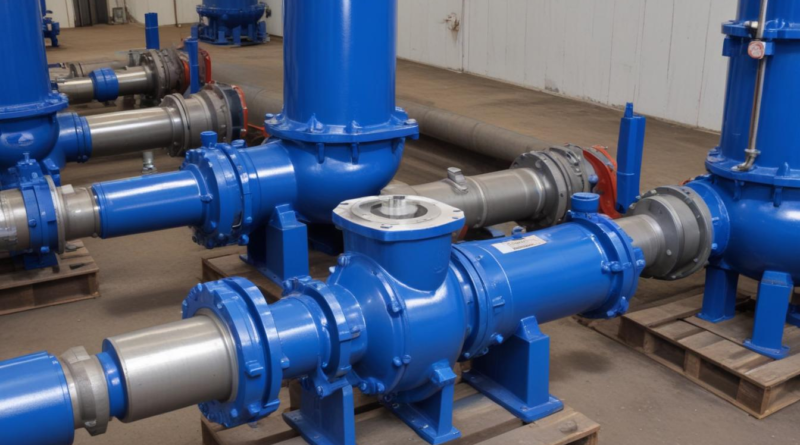Extended case studies: progressive cavity pumps in action
Progressive cavity pumps are versatile and efficient devices widely used across various industries due to their unique design and capabilities. These pumps are particularly suited for handling viscous, shear-sensitive, and abrasive fluids, making them a favored choice in numerous applications. One of the key advantages of progressive cavity pumps is their ability to provide a constant flow rate, which is critical in sectors requiring precision and reliability.
In the wastewater treatment sector, progressive cavity pumps are employed for transporting sludges and slurries, delivering consistent performance even under challenging conditions. Their capability to manage solids and maintain flow integrity contributes to improved efficiency in treatment processes.
Another significant application is in the oil extraction industry, where the pumps excel in moving heavy crude oil and other viscous fluids. Their design allows for smooth handling of high-viscosity materials, enabling companies to maximize extraction rates while minimizing equipment wear.
The food and beverage industry also benefits from progressive cavity pumps, particularly in the transfer of delicate liquids such as syrups, sauces, and emulsions. Their gentle pumping action reduces the risk of product damage, ensuring quality and consistency in production.
Progressive cavity pumps have further applications in chemical processing, pharmaceuticals, and even in the agriculture sector for transferring fertilizers and other nutrients. The adaptability of these pumps to various conditions and their capacity to handle a wide range of fluids underscore their significance in modern industrial operations.
For engineers and pump users, understanding the specific applications and benefits of progressive cavity pumps is essential for optimizing system performance. Industry case studies highlight these pumps’ effectiveness and reliability in various operational contexts, showcasing their role in enhancing productivity and efficiency.
- Wastewater Treatment: Efficient transport of sludges and slurries.
- Oil Extraction: Smooth movement of heavy and viscous fluids.
- Food and Beverage: Gentle handling of delicate liquids.
- Chemical Processing: Versatile for handling various chemical compositions.
- Agriculture: Effective in transferring fertilizers and nutrients.
The continued innovation surrounding progressive cavity pumps promises to enhance their capabilities even further, ensuring they remain integral to future advancements across these diverse applications.
Case study 1: Wastewater treatment efficiency
In a notable case study focusing on the wastewater treatment sector, a municipal treatment facility faced significant challenges in efficiently managing the flow of sludge and removing solids from its processing systems. The facility was experiencing inefficiencies due to inconsistent flow rates and frequent maintenance issues with their existing pumping solutions. To address these problems, the engineers decided to implement progressive cavity pumps designed explicitly for handling viscous materials and slurries.
The progressive cavity pumps installed exhibited remarkable performance enhancements. They provided a consistent and smooth flow of sludge, which is crucial for maintaining optimal operational conditions within the treatment plant. Several key factors contributed to the success of these pumps:
- Constant Flow Rate: The pumps maintained a steady flow even with varying sludge viscosities, preventing clogs and ensuring uninterrupted processing.
- Solid Handling Capacity: The pumps efficiently transported sludges containing large particles and solids without risking damage or reduced efficiency.
- Reduced Maintenance: By leveraging the durability and reliability of progressive cavity pumps, the facility observed a significant decrease in downtime due to fewer mechanical failures.
- Energy Efficiency: These pumps consumed less power than traditional pumps, leading to substantial cost savings on energy bills over time.
As part of the implementation, the facility undertook performance metrics collection post-deployment. The results were compelling:
| Performance Metric | Before | After |
|---|---|---|
| Flow Consistency (GPM) | 25 | 40 |
| Maintenance Costs ($/month) | 1,500 | 600 |
| Power Consumption (kWh/month) | 3,000 | 2,200 |
These results underscored the importance of modern pumping technology in enhancing operational efficiencies, particularly in the demanding environment of wastewater treatment. The successful integration of progressive cavity pumps not only streamlined processes but also provided a model for other facilities seeking to improve their system performance.
This case study exemplifies how the strategic selection of progressive cavity pumps can lead to improved efficiency, reliability, and cost-effectiveness in wastewater management, ultimately aligning with the industry’s push toward sustainable and effective operations.
Case study 2: Oil extraction optimization

In the oil extraction industry, the demand for efficient, reliable, and robust pumping solutions is paramount due to the challenging characteristics of the extracted fluids, primarily heavy crude oil and various viscous liquids. A notable case study highlights how progressive cavity pumps were implemented in a mid-sized oil field to optimize extraction processes and boost output while minimizing operational costs.
Prior to the integration of these pumps, the drilling operation encountered significant hurdles with traditional centrifugal pumps that struggled to handle the high viscosity and density of crude oil. The engineers opted for progressive cavity pumps known for their ability to provide a steady flow rate and tackle fluids with higher viscosity and solids content.
The deployment of progressive cavity pumps led to several operational improvements, which can be summarized as follows:
- Increased Flow Rates: Progressive cavity pumps delivered a uniform output, significantly improving the extraction flow rates without the pressure fluctuations often seen with other pump types.
- Enhanced Viscosity Handling: The design capabilities of these pumps allowed for effective pumping of fluids with viscosities exceeding 1,000 centipoise, which was challenging for previous systems.
- Operational Reliability: The pumps’ durable construction minimized wear and tear, resulting in fewer breakdowns and less unplanned maintenance, crucial for maintaining production schedules in an industry with strict supply chain demands.
- Energy Efficiency Gains: By operating efficiently at lower power requirements, the progressive cavity pumps reduced the overall energy expenditure, leading to improved profit margins for the oil extraction company.
Performance metrics were evaluated post-installation, demonstrating significant advancements:
| Performance Metric | Before (Centrifugal Pumps) | After (Progressive Cavity Pumps) |
|---|---|---|
| Flow Rate (BBL/day) | 150 | 220 |
| Maintenance Downtime (hours/month) | 12 | 3 |
| Energy Cost ($/month) | 4,500 | 3,200 |
These measured enhancements underline the pivotal role progressive cavity pumps play in refining oil extraction processes. The improved stability and efficiency not only maximize production but also align with the industry’s ongoing efforts to reduce operational costs and increase sustainability. This case exemplifies how the tailored application of progressive cavity pumps can lead to a significant transformation in operational efficiency within the oil sector, reinforcing their importance as a leading choice for rigorous fluid handling applications.
Case study 3: Food and beverage industry solutions

In the food and beverage industry, maintaining product integrity while ensuring efficient processing is key. A compelling case study demonstrates how a food manufacturing plant successfully integrated progressive cavity pumps into its production lines, significantly enhancing its ability to transfer various types of fluids, including sauces, syrups, and emulsions without compromising quality.
Prior to this implementation, the facility relied on conventional pumps that often resulted in shear damage to sensitive products, leading to quality concerns and increased production costs. Recognizing these challenges, the engineering team opted for progressive cavity pumps, which are renowned for their gentle handling and efficient flow characteristics.
The integration resulted in numerous operational benefits:
- Gentle Pumping Action: The progressive cavity design ensured a smooth and continuous flow, minimizing shear forces and preserving the integrity of delicate products.
- Consistency in Transfer: These pumps maintained a constant flow rate regardless of fluid viscosity, allowing for predictable operation during production cycles.
- Versatile Fluid Handling: Capable of transferring a wide range of product types, including viscous and non-viscous materials, the pumps provided flexibility in the manufacturing process.
- Reduced Maintenance and Downtime: The durable construction of progressive cavity pumps led to fewer breakdowns and maintenance issues, thus enhancing overall productivity.
Performance metrics recorded after the installation highlighted significant gains:
| Performance Metric | Before | After |
|---|---|---|
| Flow Rate (GPM) | 30 | 55 |
| Product Temperature Stability (°F) | 80 | 78 |
| Annual Maintenance Costs ($) | 2,000 | 800 |
Notably, the ability to maintain temperature stability during the transfer of hot sauces and other temperature-sensitive liquids further underscored the advantages of using progressive cavity pumps. By providing reliable and consistent flow, the pumps enabled the facility to enhance product quality while also increasing throughput and reducing costs.
This case study illustrates the critical role progressive cavity pumps play in the food and beverage sector, affirming their position as a superior choice for fluid handling in environments where product preservation and efficiency are paramount. As manufacturers continue to seek innovative solutions to optimize operations, the successful application of progressive cavity pumps serves as a benchmark for industry advancements.
Future trends in progressive cavity pump technology

The landscape of progressive cavity pump technology is evolving rapidly, bringing forth innovative advancements that enhance their performance and expand their applications across various industries. Engineers and operators should anticipate several key trends that are shaping the future of these pumps, ultimately driving further efficiency and reliability in fluid handling operations.
One prominent trend is the incorporation of smart technology into progressive cavity pumps. This includes the integration of sensors and IoT (Internet of Things) functionalities that enable real-time monitoring and reporting of pump performance. By utilizing data analytics, operators can detect potential issues before they escalate, allowing for predictive maintenance that minimizes unplanned downtime and optimizes operational efficiency. Real-time data can also provide insights into viscosity changes of the pumped fluids, enabling easier adjustments to maintain optimal flow conditions.
Energy efficiency remains a critical focus as industries push towards sustainability. Manufacturers are continuously innovating to design pumps that consume less energy while maximizing output. Efficiency improvements can be achieved through better rotor-stator geometries and advancements in materials that reduce friction and wear. Electric motor technology is also evolving, helping to deliver higher performance at lower power consumption.
Moreover, the development of modular pump designs is on the rise, allowing for easy customization based on specific applications. This flexibility means that users can modify or upgrade their systems with different components as demands change, leading to longer service life and reduced overall costs. Modular designs can accommodate varying fluid characteristics, making progressive cavity pumps adaptable to a wider range of industries beyond traditional applications.
In addition, there is an increasing focus on biocompatible materials for progressive cavity pumps used in the food and beverage, pharmaceutical, and chemical sectors. These materials help comply with stringent health and regulatory standards while ensuring product integrity and safety. The use of corrosion-resistant and non-toxic materials expands the applicability of these pumps in sensitive operations.
Lastly, as the demand for sustainable practices intensifies, progressive cavity pump technology is moving towards environmentally friendly solutions. Companies are investing in sustainable practices, including recyclable materials and energy-efficient designs, which align with global efforts to reduce carbon footprints. This trend is not only beneficial for the environment but also appeals to a growing market segment that values eco-conscious operations.
The future of progressive cavity pumps looks promising, characterized by advancements in smart technology, energy efficiency, modular designs, biocompatibility, and environmental sustainability. These innovations will ensure that progressive cavity pumps remain at the forefront of fluid handling solutions, catering to the evolving needs of modern industries.



